Experiencing Nirvana: Grunge in Europe, 1989 – e-book by Bruce Pavitt [Review]
An extensive review of the new e-book written by Sub Pop founder that chronicles Nirvana’s 1st European tour and the pivotal show that changed their careers
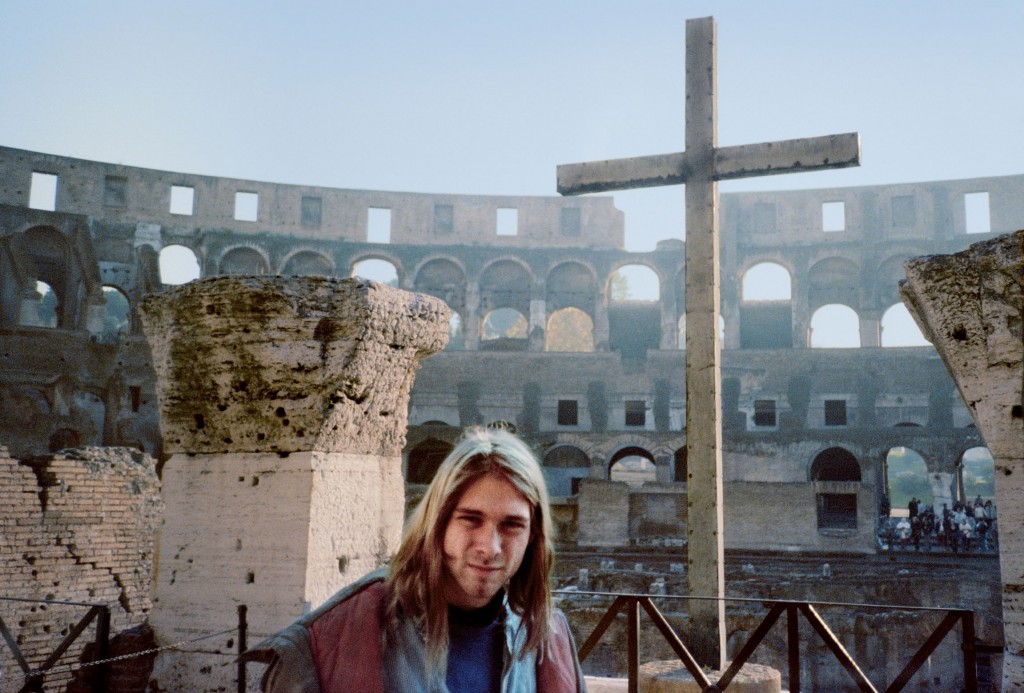
I live in Seattle. I live in a city which makes at least 2 fairly massive claims in regards to legendary pioneers of highly influential, revolutionary, and now historic, musical movements of the 20th century. Last week, the city celebrated what would have been Jimi Hendrix‘s 70th birthday, but while the man famously known for completely reinventing what the electric guitar was capable of was born and raised in the area, he actually moved away from the Northwest while still in his late teens, spending the remainder of his life living in cities like New York and London, where he was ultimately found dead in 1970. His body is now buried in the Seattle suburb of Renton, but even the musical scene that he was most closely associated with was from the bay area; not Seattle. It would take more than 2 decades after Hendrix first burst onto the scene for our city to truly create a global musical impact that would rival that of the Woodstock generation’s. When Seattle‘s big “revolution” did finally arrive, there was another power trio at the forefront and, like The Jimi Hendrix Experience, they were lead by a left-handed guitarist known for his affinity for playing Fender guitars. Tragically, also just like Hendrix, this new golden boy’s life was abruptly ended too soon at the tender age of 27. Ironically, Seattle‘s champion wasn’t technically from the city at all, but rather a small fishing/timber town known as Aberdeen. Also at the forefront of this movement was one record label–a Seattle label founded by a man who was originally from Chicago.
The E-Book – Experiencing Nirvana: Grunge in Europe, 1989
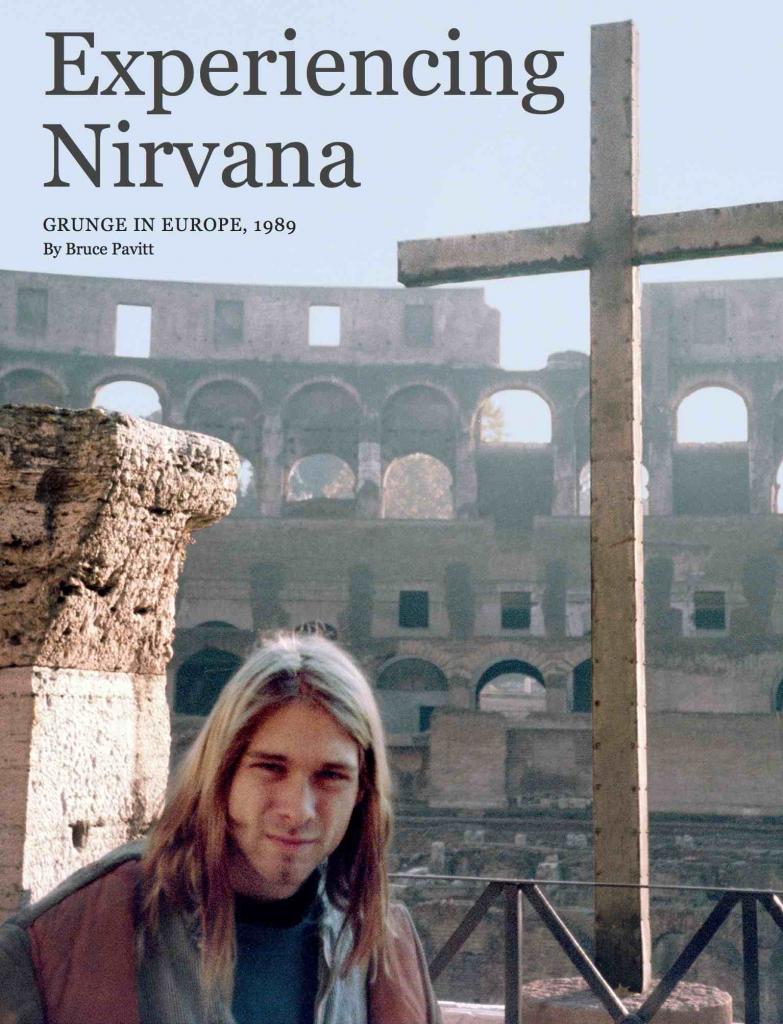 The Grunge era…
The Grunge era…
Most people know the basics, or at least the way that it’s been framed by history: Popular music had become stagnant and monopolized by nonthreatening hair bands that lacked in substance. Nirvana‘s “Smells Like Teen Spirit” hits the airwaves and shakes things up. A new sound grabs a hold of the youth. Critics everywhere are eating it up. Kurt Cobain and Nirvana are widely championed as heroes. All eyes are on Seattle, a town that’s universally considered to be the new epicenter for cutting edge music. GRUNGE becomes a movement. Bands like Pearl Jam, Soundgarden, and Mudhoney become household names. GRUNGE is essentially reduced to a generic formula that is imitated the world over (see: Silver Chair, Bush, etc). Nirvana is the “hottest” band in the world, but they continue to make music on their own terms. The Bon Marche begins selling flannels in the youth section that have hoods sewn right into them to simulate layering. Kurt Cobain becomes the poster boy for this new cultural “movement,” under no desire or intention of his own, and, as that scene continues to become appropriated and aggressively marketed by corporate interests, he reluctantly remains that poster boy. Cobain continues to create outside of any homogenized collective or ideals imposed upon him, just as he always has. He considers trying to remove himself from music altogether. He moves forward, finding selective and positive ways to utilize the spotlight directed toward him, such as redirecting it toward acts that he feels deserved the attention as much as, if not more than, he did, but never received it (The Raincoats, The Vaselines, Meat Puppets, The Wipers, Daniel Johnston, The Pixies, etc.). Kurt turns up dead in ’94. By the end of the decade, boy bands are everywhere.
The new e-book by Sub Pop records founder, Bruce Pavitt, lengthily titled Experiencing Nirvana: Grunge in Europe, 1989, brings a slightly different angle to this narrative. Utilizing the unique perspective that only someone like Bruce–an early believer/supporter in the then-underground Seattle music scene and invaluable figure behind it’s ultimate success–could have, Pavitt‘s new offering focuses on a time period before the term “Grunge rock” had truly become a part of the popular lexicon and a widespread phenomenon. Back then, the idea that the Emerald City was brewing up a musical force to be reckoned with was only at it’s very early stages of picking up steam. Set over an 8 day period (November 27 through December 4, 1989) at the tail end of a strenuous 6-week co-headlining European tour for Nirvana (pre Dave Grohl) and fellow Sub Pop recording artists and grunge pioneers, TAD, the e-book chronicles a moment when these bands and their label were still struggling visionaries on the cusp of world recognition. At this point, Nirvana‘s debut LP, Bleach, hadn’t even been released for a full 6 months yet.
ON A PLANE
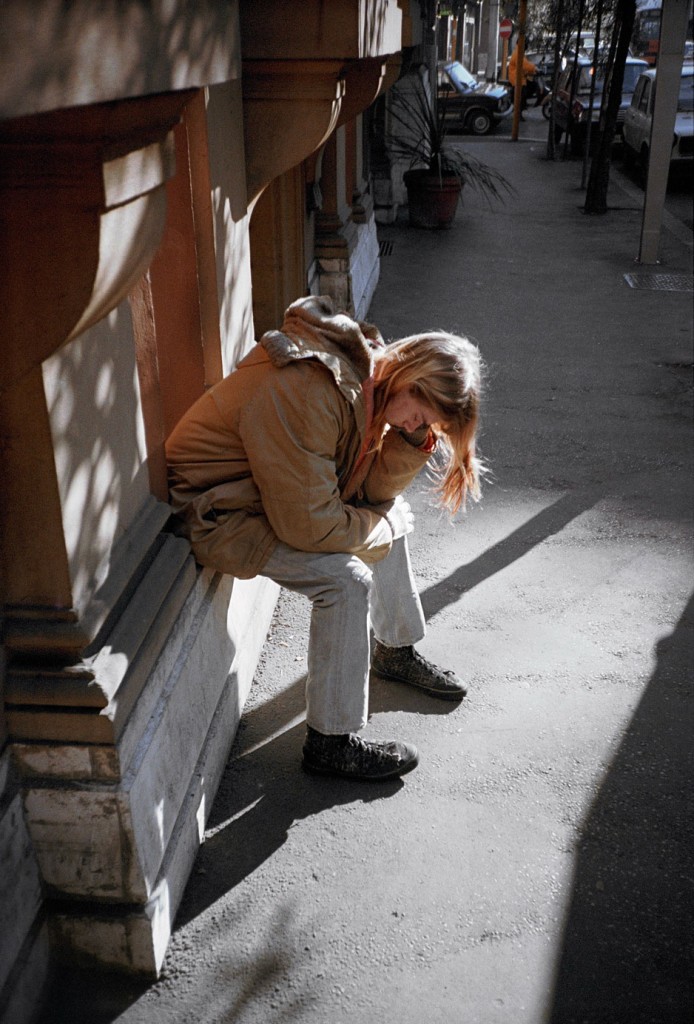
Experiencing Nirvana begins with an introduction (from Pavitt), a foreward (by Keith Cameron, the contributing editor from MOJO magazine), “a note on photo quality” (basically an explanation that the accompanying photos were taken casually with a simple Olympus XA pocket camera), and an interactive map (we’ll get to that later), but the story itself begins with Bruce and his Sub Pop business partner Jonathan Poneman arriving in Rome on Monday, November 27th 1989. Pushing a month and a half into a grueling tour with little to no sufficient breaks, Nirvana frontman, Kurt Cobain, was burnt out and suffering from what was credited as “nervous exhaustion.”
In less than a week, the Nirvana/Tad tour would intersect with the tour of labelmates and Sub Pop‘s flagship band, Mudhoney to perform at an event known as Lamefest UK at London‘s Astoria Theatre. The first Lamefest, also consisting of all 3 of these acts on one bill, was a hugely successful event, selling out Seattle‘s historic Moore Theatre and proving that locals acts could actually possess some commercial viability. The hope was that something equally as impressive could be pulled off in the UK. Since their bands weren’t gaining any sufficient mainstream attention in the states and Bruce and John were aware that UK magazines like Sounds, Melody Maker, and New Musical Express were the real tastemakers in the music press, willing to give US bands that were willing to tour the UK attention, while in a constant battle with each other to be the first ones to break new acts, they were relying on this Lamefest UK event to provide their label and acts a needed boost into the public consciousness. Sub Pop was already getting some recognition from the highly respected BBC Radio‘s DJ/journalist John Peel and the buzz was already better overseas. Essentially, to get their own country to listen, Pavitt and Poneman believed that gaining that attention in the UK first would best route for them to take.
Pavitt states that their decision to make that trip out to Rome was with the intention to make sure that they could provide any necessary assistance first hand to the bands and insure that the Lamefest showcase went off as smoothly as possible. When it was all said and done, Nirvana wowed the UK fans and critics, generating the lion’s share of positive press from the event, and embarking on a path that would solidify both the band’s and Seattle‘s burgeoning indie scene’s role in musical history. At the time, Kurt’s unstable emotional condition had the potential to derail all of that, first and foremost.
AN INSIDER’S TAKE
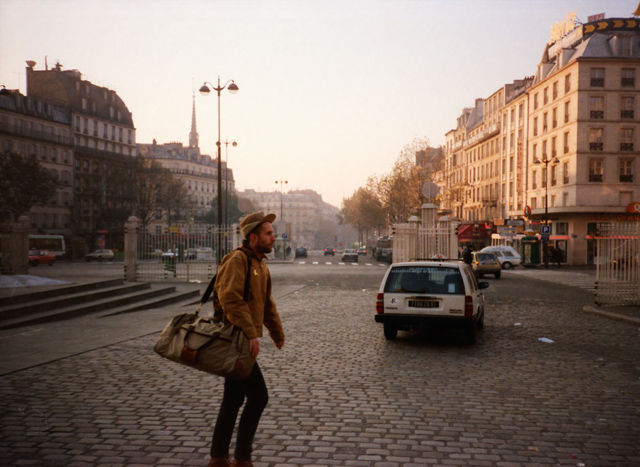
It doesn’t come across like the tale of a prima donna rockstar pulling some Lindsay Lohan bullshit and refusing to work–Cobain was actually questioning fame and popularity even then, explaining that he freaked out and climbed the stack after looking into the audience and noticing that the people in attendance reminded him of “The kind of guys who used to beat [him] up in high school“–nor does it feel like a manic scenario of a corporate label owners trying to overwork their cash cow beyond his threshold and expecting him to endanger his well being simply for their monetary gain. Nirvana  wasn’t a big name yet–they would actually be the opening act at the Lamefest UK showcase–and Sub Pop was still just a struggling indie label trying to stay afloat. By the way that Experiencing Nirvana is delivered, it seems clear throughout that there was genuine respect for each other and that Bruce and Jon were legitimate fans of Kurt‘s music who felt honored to be involved in the scene that they so strongly believed in. They weren’t buying him a guitar and attempting to appease him because he was Kurt Cobain, they were doing it because he was a friend of theirs that they believed in, because they understood how draining the tour must have been, and because they were all in it together. Pavitt says that they flew out to provide “support” and that’s exactly what they appear to have done. It’s also all that he really bothers to take credit for in this book: providing support to the artists and causes that he believed in; that and his and Jon’s recognition of talent and their willingness to go to the lengths of trying to promote it.
wasn’t a big name yet–they would actually be the opening act at the Lamefest UK showcase–and Sub Pop was still just a struggling indie label trying to stay afloat. By the way that Experiencing Nirvana is delivered, it seems clear throughout that there was genuine respect for each other and that Bruce and Jon were legitimate fans of Kurt‘s music who felt honored to be involved in the scene that they so strongly believed in. They weren’t buying him a guitar and attempting to appease him because he was Kurt Cobain, they were doing it because he was a friend of theirs that they believed in, because they understood how draining the tour must have been, and because they were all in it together. Pavitt says that they flew out to provide “support” and that’s exactly what they appear to have done. It’s also all that he really bothers to take credit for in this book: providing support to the artists and causes that he believed in; that and his and Jon’s recognition of talent and their willingness to go to the lengths of trying to promote it.
The e-book that Bruce Pavitt has created feels incredibly honest and genuine; an opportunity for him to share some of his insights and memories from the heart. The story is not entirely about Nirvana and, beyond just covering the other bands on the tour, there are moments when Pavitt veers off into speaking about the label, the general time period, or specific perspectives that he had, but he delivers that information so organically that it naturally makes you want to follow him to those places, never feeling as if he is ever truly getting off track. No information is taken for granted and no assumptions are made, with Bruce casually filling in the reader about everything from what was happening in the industry at the time to who Kurt Cobain was. No one is left behind and, even if you’ve somehow miraculously never heard about Nirvana or the rise of grunge, there would still be something worthwhile in this book, even just to explore the contrasts between the current music industry/climate from one where it took a lot more than a Youtube video and a Pitchfork rating for an independent artist to really get their names out there. For those that feel that they do have a fairly solid grasp on Cobain, Nirvana, grunge, Sub Pop, and what was going down with whole scene overall, this is only likely to add to that understanding and/or tweak it altogether. Of course, being old and having experienced that time period in my lifetime, I’m likely being dismissive of the fact that so many younger folks actually may not be familiar with the group and their legacy. Fortunately, Pavitt has not made the same mistake, consciously creating a very accessible and enjoyable read.
Most importantly is that the project reminds us of what made the grunge period so potent and what caused so many of us to be inspired by and connect so strongly with bands like Nirvana and Mudhoney, who Bruce affectionately refers to as “a crew of ‘losers’ hustling outside of a rigged corporate system.” Before the culture was raped by the media; the appropriation of corporate interests; and, above all, time; there were simply real people, creating real art, and finding a way to survive at it, making it work in an environment that was working against them.
A PHOTO JOURNAL
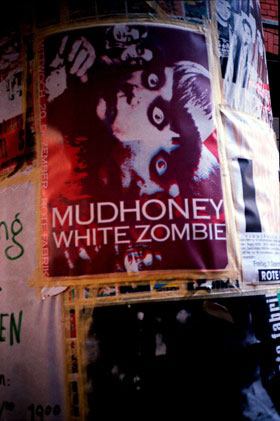 The photos in this post are only a small sample of the ones provided in the e-book–photos that, apparently, sparked it’s creation and release in the first place. In 1996, about a year after 49% of Sub Pop’s stock was sold to the Warner Music group, Pavitt parted ways with the label that he co-founded. Since then, he’s lived on Washington State‘s Orcas Island with his family and become less of a public figure. It’s understandable that he’d have little interest in revisiting much of that time in his life, especially after Kurt‘s death in 1994. After rediscovering these photographs taken during Nirvana‘s debut European tour, he recognized their ability to narrate what he refers to as a “microhistory” of an early, pivotal time in the band and label’s growing legacy. With live shots of the shows, enthralled crowds, backstage footage, a Rough Trade store signing event with the artists and fans, and simple sightseeing/travel photos or just of the guys hanging out, it’s all pretty great. One of my favorite shots is of a Mudhoney show flyer [left] for an upcoming December 20th show in Zurich that appears to list White Zombie as the opener (show was later canceled). The candidness of the photos, taken with a rangefinder pocket camera (some complete with untreated red eye), adds immeasurably to Pavitt’s intimate story telling and makes it feel like you are sitting on his couch in his home and looking through photo albums. They also work as a reminder that documenting a feeling or memory doesn’t always benefit from trying to overly control, set up, or fabricate your environment; it’s actually more likely to be detrimental to it. This e-book has also been described as part photo journal, but it really feels a lot like a home movie, with a delivery that’s extremely casual and inviting, above all.
The photos in this post are only a small sample of the ones provided in the e-book–photos that, apparently, sparked it’s creation and release in the first place. In 1996, about a year after 49% of Sub Pop’s stock was sold to the Warner Music group, Pavitt parted ways with the label that he co-founded. Since then, he’s lived on Washington State‘s Orcas Island with his family and become less of a public figure. It’s understandable that he’d have little interest in revisiting much of that time in his life, especially after Kurt‘s death in 1994. After rediscovering these photographs taken during Nirvana‘s debut European tour, he recognized their ability to narrate what he refers to as a “microhistory” of an early, pivotal time in the band and label’s growing legacy. With live shots of the shows, enthralled crowds, backstage footage, a Rough Trade store signing event with the artists and fans, and simple sightseeing/travel photos or just of the guys hanging out, it’s all pretty great. One of my favorite shots is of a Mudhoney show flyer [left] for an upcoming December 20th show in Zurich that appears to list White Zombie as the opener (show was later canceled). The candidness of the photos, taken with a rangefinder pocket camera (some complete with untreated red eye), adds immeasurably to Pavitt’s intimate story telling and makes it feel like you are sitting on his couch in his home and looking through photo albums. They also work as a reminder that documenting a feeling or memory doesn’t always benefit from trying to overly control, set up, or fabricate your environment; it’s actually more likely to be detrimental to it. This e-book has also been described as part photo journal, but it really feels a lot like a home movie, with a delivery that’s extremely casual and inviting, above all.
THE TECHNOLOGY/FORMAT
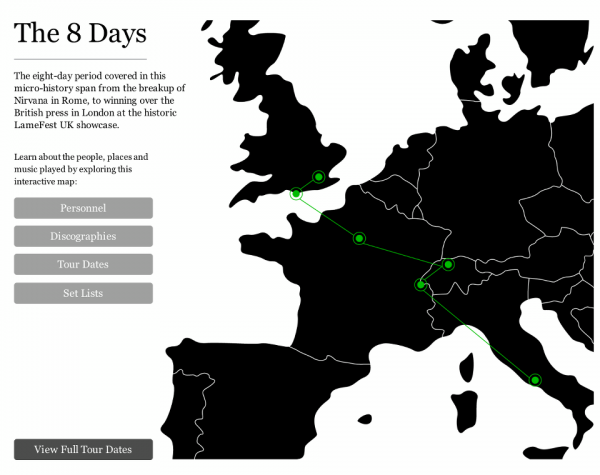
Another notable aspect of Experiencing Nirvana is that it was created entirely with Apple‘s iBooks Author book creation app with the assistance of collaborator, Dan Burke. The press release claims that Pavitt views the app as “the natural evolution of the DIY ‘zine culture where he first cut his teeth.” I can understand that from the perspective as someone creating the book, but as someone who doesn’t own an iPad and who, consequently, cannot take full advantage of the format, it feels like a bit of a stretch. The benefit of a zine is that it’s lo-fi as fuck and extremely accessible for broke fools, like myself. The requirement of an iPad adds an elitist bend to it, which is ironic, considering how non-elitist everything else about the project is, from the content and images to the delivery. That being said, I’ve read that a physical copy is scheduled for a future release and, while I only requested a PDF for review (again, I don’t own an iPad), the features look like they would be pretty amazing if one was able to take full advantage of all of the ones that are provided. There are hyperlink options that lead to tour dates, set lists, discographies, and personnel of those on the tour, as well as an interactive map. The various images that you are able to scan through have all been previously unreleased prior to the book release and, during the section covering Lamefest UK, there even appears to be an option to listen to audio of some live cuts (specifically “Polly”).
I’m not entirely sure how I feel about the close connection to Apple, as I don’t use a Mac and it seems restrictive to the rest of us, at this point. [Pavitt actually supported the book with a “meet the author” session at the SOHO apple store in NY last month.] And then, of course, as I’ve already stated, the restrictive access and implication of corporate loyalty appears to conflict with the overall dynamic of the project itself. The very last thing included in Experience Nirvana, just before the thank yous and credits sections, is a list by Pavitt titled “50 SONGS I HEARD AT SHOWS AND PARTIES IN 1989,” which includes tracks by names like Beat Happening, The Butthole Surfers, Flipper, Hüsker Dü, Scratch Acid, Pussy Galore, and more, providing an additional look into what was swirling around their environment at the time. (I read more than once that the first time that Bruce or Jon Poneman ever heard NWA was in the van with Nirvana while traveling from San Francisco to San Jose, also in the winter of 1989). The cool thing is that this list is not entirely reliant on the iPad format, however, just under the chart of songs it states “Note: We wanted to include Tad songs but they are not currently available on iTunes. Please find these critical Tad songs: Daisy, Sex God Missy and Wood Goblins.” There’s something that I don’t like about the idea that the format has affected/altered the content, but I do understand it as just one more way for Bruce to try and make the experience more interactive for the reader.
RELATED PUBLICITY FROM 1989
The end of the book includes various articles, reviews, and interviews taken from a selection of UK magazines covering the tour and the acts around that time. They aren’t all entirely Nirvana related–at least one refers solely to Mudhoney–but they do all add to the overall narrative presented. To provide further examples of the environment, context, and time when this coverage and tour was taking place, the e-book includes scans of the actual articles and even the magazine covers (featuring U2, GNR, Kate Bush, Happy Mondays, NWA, and Stone Roses) to accompany the texts and transcripts. If a basic storyline can be pulled from Experiencing Nirvana, it’s basically that, after Kurt approaches a nervous breakdown, Nirvana trudges on through various obstacles (including the loss and reissue of Cobain’s passport) along with their cohorts, only to arrive at their final destination of Lamefest UK with about 20 minutes left before they were supposed to go on. From there, as an unsuspecting opener, they won over the crowd with a magnificent performance, stealing the show, and earning a shit ton of amazing reviews. The prequel/microhistory pretty much ends there on a good note, but, as we all already know, they went on to become one of the most important and influential bands in history. Aside from the benefit of being able to revisit those early interview transcripts, however, the best part of the magazine articles being provided is that they don’t necessarily reinforce that narrative 100%, but Bruce still makes sure to include them, even if they contradict his own interpretations of the events that took place.
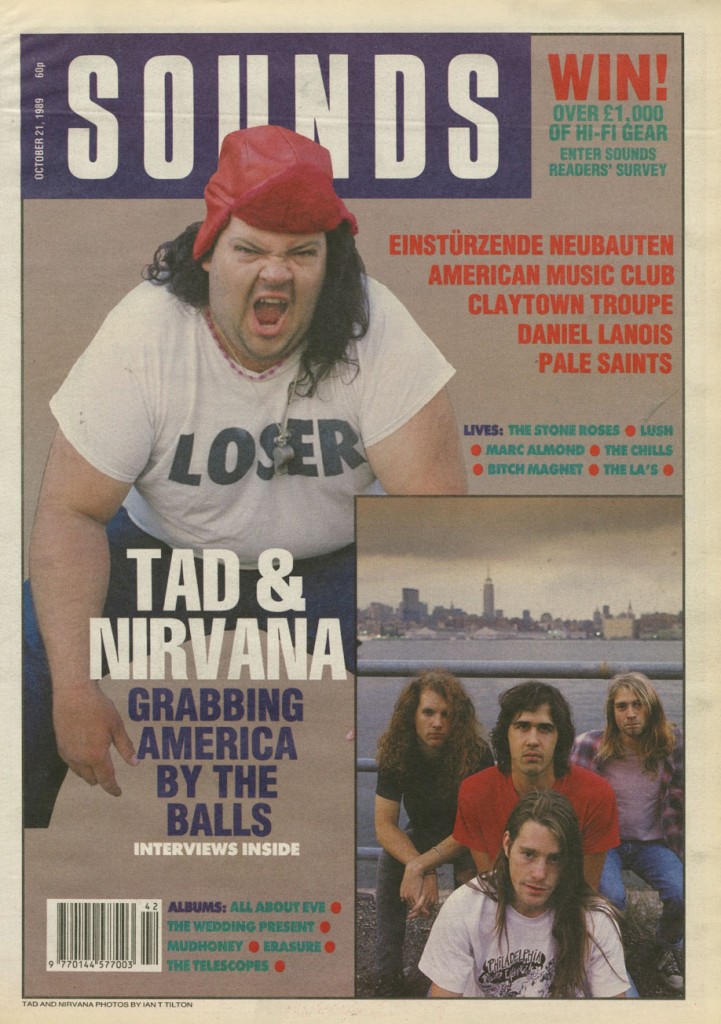 While it’s true that a lot of positive reviews were received from Nirvana‘s Lamefest UK performance and that a great case could be made for that event, and it’s post-event publicity, as a huge milestone leading to Nirvana and Sub Pop‘s success, plenty of people were actually less than impressed; some even remember their set as being horrendous. The biggest praise may have come from NME, who dubbed Nirvana as “Sub Pop’s answer to the Beatles,” but the article also seems to imply that TAD‘s performance was equally as good. Probably the most vocal hater to the cause was Melody Maker‘s Simon Price who was “unmoved” by Nirvana, going as far as to claim that their “lanky, rubberlegged, frog-like bassist” had “to go.” Furthermore, the UK critic slagged on the entire show, only paying any real credence to Mudhoney, which he undercut by saying “It ain’t art, but I’m feeling charitable.” [Side note: I actually found a 2010 response to his article by Simon where he states that he “remained (mostly) unmoved even through the Nevermind era. It took In Utero (genius) to blow all [his] reservations away.” So what the fuck did he know?]
While it’s true that a lot of positive reviews were received from Nirvana‘s Lamefest UK performance and that a great case could be made for that event, and it’s post-event publicity, as a huge milestone leading to Nirvana and Sub Pop‘s success, plenty of people were actually less than impressed; some even remember their set as being horrendous. The biggest praise may have come from NME, who dubbed Nirvana as “Sub Pop’s answer to the Beatles,” but the article also seems to imply that TAD‘s performance was equally as good. Probably the most vocal hater to the cause was Melody Maker‘s Simon Price who was “unmoved” by Nirvana, going as far as to claim that their “lanky, rubberlegged, frog-like bassist” had “to go.” Furthermore, the UK critic slagged on the entire show, only paying any real credence to Mudhoney, which he undercut by saying “It ain’t art, but I’m feeling charitable.” [Side note: I actually found a 2010 response to his article by Simon where he states that he “remained (mostly) unmoved even through the Nevermind era. It took In Utero (genius) to blow all [his] reservations away.” So what the fuck did he know?]
Journalist, Everett True, who is famously credited as being the first real established journalist to champion Nirvana and Sub Pop early on, as well as the first to interview the band, had a different impression of the events than his Melody Maker colleague, Price: he thought they were great. In True‘s 600 page book Nirvana: the Biography, he spoke out about how the interpretation of that Nirvana performance was “all over the place,” but agrees that “in many respects” it “was the show that changed everything.” He acknowledges that his viewpoint and memories of the show may be the ones that are off, but adds , “Yet, I’m sure this is the night that I first really connected with the power and rage and frustration and sheer devilment of Kurt Cobain.” Later he states, “My recollection is that it was the first time I ever liked them live. I may be confused…” In that same section of True‘s biography, Mudhoney drummer (and future/temporary Nirvana drummer) Dan Peters claims that Nirvana was “fucking horrible and fucking shitty,” swearing that if you spoke to anyone else from Mudhoney they’d agree. However, Mudhoney guitarist, Steve Turner doesn’t even believe that he watched the majority of the set and both Mark Arm (singer) and Matt Lukin (bass) were stage diving during Nirvana‘s set. In Pavitt‘s e-book, one of the exclusive photos is of Arm standing next to Peters, while looking at the camera and pointing out from the side-stage in awe. Under the image it reads “Mudhoney frontman Mark Arm can’t believe the impact that Nirvana is having on the crowd,” but I guess the question of if he was in awe because they were amazing or because they were terrible could be up for debate. That being said, True‘s book also quote’s Krist Novacelic himself as saying that the show “stunk” and that “on a scale of 1 to 10 it was a zero.”
While that specific information from Everett True obviously comes from an alternate piece of literature, the variance of opinion and insight into the different viewpoints at that time is something that is definitely touched on in Experiencing Nirvana and it’s something that provides a fascinating dimension to the project. In a Melody Maker interview between True and Nirvana, included in Pavitt‘s e-book, Novacelic insists that his group is “definitely not groundbreaking.” Perhaps the most interesting piece included is that of an interview/cover piece by John Robb (now of Louder Than War) for the October 21st, 1989 issue of SOUNDS magazine (cover image featured above left), which was wrought with misconceptions and errors. While mentioning previous contributions to the group by legendary Melvins drummer, Dale Crover, Robb refers to him by the name “Del.” Then, while discussing Nirvana‘s first single, “Love Buzz,” he states that it’s a cover of a song by “Screaming Blues” rather than the late 60s/early 70s dutch group, The Shocking Blue–this is a shameful mistake to make for a music journalist and publication, which should have been easy enough to fact check back then, even without the world wide web. But above all the problems with John Robb‘s piece, my favorite statements are those that he makes about Jason Everman, the very temporary second guitarist for Nirvana, who performed at Seattle‘s Lamefest in June of 89, but was already booted by the time the European tour being chronicled in the e-book came around. As most hardcore Nirvana fans know, although Everman was credited as performing on Bleach and is featured on the photo negative cover art, he never actually appeared on the album; rather he was only listed out of gratitude for being the one that lent them the $606.17 that it cost them to pay producer Jack Endino for the recording session. Still, factual accuracy doesn’t prevent Robb from giving Everman a surprising amount of credit by saying that “His wicked onstage demeanour and ass splattering six-string made him a crucial cornerstone on the band’s love buzz” (which he never played on) and follows it up by pondering how, “It would be interesting to see how they fare as a threepiece…” I know that I’ve mentioned how perception can often shift from one individual to the next, but I personally happen to feel that the 3-piece setup worked out alright for them, in the long run…
LAMINATED EFFECT

More than just capitalizing off of simple nostalgia, Experiencing Nirvana: Grunge in Europe, 1989 is actually highlighting a whole new chapter, one that took place before all of the hype. It’s a refreshing account that still feels surprisingly vital and relevant. Being that it’s promoted as a “microhistory” and a document of specific events at a particular time period, it may seem ridiculous and misguided for me to say this, but the exact details behind the events chronicled throughout the e-book, may not even be that important. Through time, history will naturally calcify into one narrative or another, and that’s probably unavoidable, but this is the story of one man’s recollection of how he experienced a moment in his life that was not only important to him on a personal level, but also had a lasting impact on the world at large. It’s also an opportunity to present some of this information by focusing on the energy and emotions that fueled these events.
In Everett True‘s Nirvana biography, he makes the claim that the 8 day trip that Pavitt and Poneman made out to Europe was “a typically extravagant and somewhat thoughtless gesture… much to the resentment of the bands being forced to get by on sleep deprivation in cramped surroundings, barely breaking even.” He further states that, in regards to TAD and Nirvana, “Rome would prove to be the beginning of the end of Sub Pop’s relationship with both bands; the musicians viewed their appearance… as sheer arrogance, the act of record company moguls out of touch with their roster.” That being said, he does concede that the efforts were, “intended as emotional support, a pair of friendly faces to help prop up flagging spirits.” Of course, if the bands truly did view the first hand approach of the struggling indie label owners as flamboyantly egotistical and “out of touch“ it begs the question as to how the choice of signing to major labels would have worked to remedy such concerns. Keep in mind that this is the same Everett True that the label had already famously flown out to Seattle, basically gift wrapping the article that would allow him to be credited as the one who “broke” grunge; a brilliant and out of the box business move that proved immeasurably beneficial to the future careers of all involved. But if interpretations do matter, I’ve always kind of had the impression that Everett True was somewhat of a dick, anyway, and Bruce Pavitt has, in my limited exposure, always presented himself as quite sincere with his intentions. In fact, that might be the one thing above all that really separates each of their respective documentations on Nirvana: Bruce‘s e-book is incredibly inviting, avoiding the crass elitist commentary that’s prevalent in the work of so many career music journalists.
In Keith Cameron‘s introduction, he credits the label heads for their vision, feeding into “an audience’s natural desire to feel like participants in a social movement, rather than mere spectators at an exhibition.” Pavitt takes a similar angle with the e-book itself and, by combining his unedited “amateur” photography with a casual delivery he places the importance on emotions first. It’s a very nonabrasive and unforced approach that really made it feel as if I was traveling along with them, observing, and genuinely “experiencing” the events first hand, which is somewhat remarkable. Through this process, he’s able to effectively present Kurt Cobain in the more authentic and accessible light of a young artist with integrity, even one that still appears genuinely honored to sign autographs and discuss music with his fanbase, rather than the troubled, suicidal, millionaire, rockstar whose face is now silkscreened onto T-Shirts from Hot Topic and whose image has been licensed as an avatar singing Bon Jovi and Journey songs in a videogame.
But if there’s one thing that truly drives this tale, and seems to drive Bruce Pavitt in general, it’s the author’s belief in the importance and power of independent art and artists, along with his mission to continuously foster support for them. This is something that has remained evident since Sub Pop‘s origins as a radio program at The Evergreen State College station KAOS in Olympia, Wa back in 1979, all the way up through now, with a portion of the proceeds from the sale of this e-book actually going to support Seattle‘s non-profit organization The Vera Project, which not only puts on all-ages events, but also provides music related training courses for the community. If there’s a singular purpose behind Experiencing Nirvana, I have to believe that it is to help infuse a new generation with the energy to pursue their own visions. There’s honesty and humility in his story; a perspective that you won’t likely find anywhere else, and it comes from someone who embarked on an overwhelming endeavor of their own. Sure, this is a story of people overcoming obstacles because they believe in something and have a stake in it, but it’s mostly a story about being willing to put a stake in something that you believe in.
Experiencing Nirvana: Grunge in Europe, 1989 is available now through iTunes by clicking here.